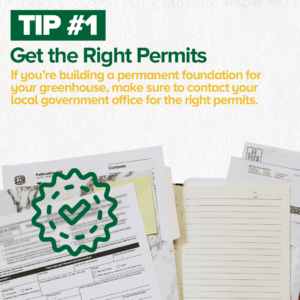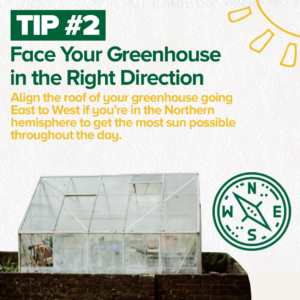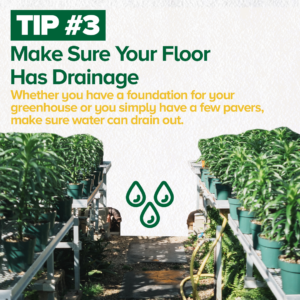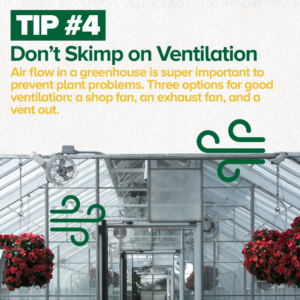A Beginner’s Guide to Greenhouses
There comes a time in every plant parent’s life when we start to get curious and excited about having a dedicated space for all of our plants. If you’re an outdoor gardener, the promise of a greenhouse for seed starts and overwintering plants is even more exciting!
If you feel like you’re ready to take the leap of installing a greenhouse – whether it’s a small kit, or a large structure in your backyard – consider this blog a beginner’s guide to building the greenhouse of your dreams!
This blog is inspired by Episode 151 of Bloom and Grow Radio Podcast, where host Maria Failla interviewed Patrick Grubbs, founder of Greenhouse Info.
 Do Greenhouses Need Permits?
Do Greenhouses Need Permits?
Before you even begin shopping for greenhouses, you need to consider licensing and permitting. In the US, we have two authorities you should keep in mind when you’re building a greenhouse: zoning regulations and building codes. Almost always, you can simply contact your local government office and they’ll be able to tell you all of the required permits for an accessory building with a permanent foundation.
The one exception? If you’re getting a small greenhouse (or a cold frame) where you don’t need to set up a foundation, those generally aren’t regulated since they aren’t really considered permanent structures. Usually, these are cheaper greenhouse kits that cost about $500 or less.
What’s the Best Greenhouse Construction Material?
Here are the pros and cons to each type of greenhouse material to help you choose the best option for your space.
Glass is a classic greenhouse material.
- Pros: it lasts forever and is easy to maintain. It’s a great long-term option for permanent greenhouses.
- Cons: it’s expensive, fragile, and not a great insulator in general. Insulation is really important for greenhouses, especially if you’re in a Northern climate.
Polycarbonate is one of the most common greenhouse materials.
- Pros: it’s strong, durable, and much lighter than glass.
- Cons: it starts to yellow and degrade after about 10 years, reducing the amount of light to your plant. Opt for the UV resistant choice to help it last longer.
Acrylic is another common greenhouse material (brand names like plexiglass).
- Pros: strong and durable
- Cons: fairly expensive and heavy, contracts with temperature fluctuations so you may need a special mounting solution to attach it.
Polyethylene is another plastic greenhouse material.
- Pros: can buy rolls of plastic to replace material
- Cons: flimsy plastic, likely only used as a temporary material as it’s really only good for one season
Should I use a Greenhouse Kit or DIY My Own Greenhouse?
For a beginner greenhouse hobbyist, a kit is a great option. It’s more affordable, has instructions, and great to start with. A smaller 6’ x 8’ kit that doesn’t need a foundation is a good option and will take a few hours to put together with a group of helpers. Once you get into more of the reclaimed windows and doors for a do-it-yourself greenhouse, carpentry skills are much more of a necessity.
If you want a permanent structure with a foundation and electricity, it might be time to look into other options outside of kits. This kind of project could require a backhoe, 6’ holes, and electrical wiring to get it up and running.
How Much Should I Pay for a Beginner Greenhouse?
A standard 6’ by 8’ greenhouse kit is one of the cheapest starter greenhouses you can get. These kits will probably run you about $500 to $600 for a new kit. Pro tip: check Facebook Marketplace and Craigslist for used greenhouses–you’ll often find some great options for a fraction of the cost.
When you consider the extra components you need to buy, like fans and heaters, it’ll probably end up costing you around a thousand dollars for a very entry-level greenhouse that will satisfy.

What Direction Should My Greenhouse Face?
The point of a greenhouse is to capture the heat from the sunlight and maximize the exposure your plants get. The best way to do that in the Northern hemisphere is to align the roof of your greenhouse going East to West. That will ensure you get the maximum amount of sun in both Winter and Summer. Keep in mind that this is the reverse if you’re in the Southern hemisphere.
What Kind of Floor Should My Greenhouse Have?
The primary consideration for your greenhouse flooring is drainage. If you have a big greenhouse, you might have a foundation underneath like a concrete slab. And in this case, you need to be sure that any water you pour in your greenhouse can get out.
If you don’t have a foundation, you still have the same consideration regarding drainage, it’s just much easier to handle. It can be as simple as concrete pavers with gravel in between. That provides a flat surface, it’s easy to clean and walk on, and it’s stable. Since there’s space in between the pavers, there’s room for water to drain into the ground.

Greenhouse Ventilation Requirements
Greenhouses are super effective at their jobs. They can raise the temperature anywhere from five to 30 degrees Fahrenheit greater than the ambient temperature. You could very easily cook your plants if you don’t have proper ventilation.
The first thing you need to do for all of your greenhouse air conditioning needs is to calculate the total volume of your greenhouse. Multiply the length times the width times 1.5 of the height, which accounts for the volume that isn’t really there at the top. This number will tell you the cubic feet of air in your greenhouse.
You’re going to reference this number whenever you’re looking at ventilation or heating options. You want to try to cycle all of the air in your greenhouse in one minute. If you have a 10’ by 10’ by 10’ greenhouse, that equals 1,000 cubic feet of air. You then need to find an exhaust fan that is rated to push 1,000 cubic feet of air per minute.
Greenhouse Fans
There are a couple types of fans for greenhouses. First is a shop fan or a desk fan, which works for pushing air around, but it’s not the most effective way to cool a greenhouse.
And second is an exhaust fan that’s set into the walls of your greenhouse and moves air from inside to outside and vice versa. Usually these fans come in pairs so you can put one on each side of the greenhouse to circulate air efficiently.
Greenhouse Vents
There are many different kinds of greenhouse vents, but the best options are solar vents. They have wax inside of them that expands and contracts when it gets warm, which automatically opens and closes the vents with no electricity. Most greenhouse kits you buy probably won’t have any ventilation built in, so make sure to factor that into the cost of building a greenhouse.
Ventilation is a necessity for a greenhouse in order to control the humidity, temperature, and air flow. Plan to incorporate fans and vents for proper greenhouse ventilation.
Managing Humidity and Mold in Your Greenhouse
Ventilation is your number one defense against humidity. A trick to dealing with root rot or mold is to have airflow underneath your pots.
Many greenhouses have plant benches and the bottom of the bench is actually a grate so air and water can freely flow through. This is important because it means the air accesses the plant roots, which is where plants take in most of their oxygen. Having that additional airflow dries out the potting media faster, which will help prevent mold and rot.
What’s the Ideal Greenhouse Temperature and Humidity?
A good greenhouse temperature is around 80 to 85 degrees Fahrenheit, but it all depends on what you’re growing. Opt for low humidity, especially in Summer, so temperatures are more bearable.
To really control the temperature in your greenhouse, try a remote thermometer. It makes monitoring the temperature much easier, especially when dealing with snow and freezing outdoor temperatures. You can also plug all of your appliances into a smart plug bar. The bar allows you to connect to Bluetooth using an app, which helps you control temperature, light, and humidity from your phone.
3 Beginner Greenhouse Tips from Patrick
Tip 1: A greenhouse isn’t necessarily the next step for improving your gardening skills. It’s a whole different category. Unfortunately growing in a greenhouse alone won’t make your plants healthier and happier: there’s a learning curve. Make sure you dial in the right parameters to optimize growth in your greenhouse to get those happy plants.
Tip 2: You will deal with pests in greenhouses, but you have options. Greenhouses can actually give you enough space for a dedicated quarantine section of insect-ridden plants. You can use a corner shelf with all of your remedy supplies, far away from other plants. Put a sticky note with the date you placed it on the shelf, then transition it to the rest of your plants after about a month.
You can also implement predatory insects in your greenhouse. Some great examples are ladybugs, praying mantises, lacewings, and parasitic wasps. Just make sure you’re not purchasing the invasive ladybug.
Tip 3: If you’re not in a place in your life where you expect to be there for a while, then a greenhouse probably isn’t the best option. It’s a big investment in terms of money, time, and space. Many of them are at least a 10 year commitment unless you have a way to transport it. You still have options, like a cold frame or something a bit smaller like a grow tent.
To learn more about greenhouses, check out Patrick’s website Greenhouse Info.
*****
About Bloom & Grow Radio Podcast
Bloom & Grow Radio Podcast helps people care for plants successfully and cultivate more joy in their lives. Host Maria Failla, a former plant killer turned happy plant lady, interviews experts on various aspects of plant care, and encourages listeners to not only care for plants, but learn to care for themselves along the way.
About Our Interviewee
Patrick Grubbs has a B.S. in Biology, where he fell in love with plants through his first botany class. He’s published aquatic ecology research and authored several books related to succulents and gardening pests.
Patrick has spent a great deal of his career split between science communication and hands-on permaculture and ecology projects. His passion is teaching other people to enjoy plants and animals the same way he does.
Follow Patrick:
from
https://summerblakeley.wordpress.com/2022/07/29/beginners-guide-to-greenhouses/
No comments:
Post a Comment